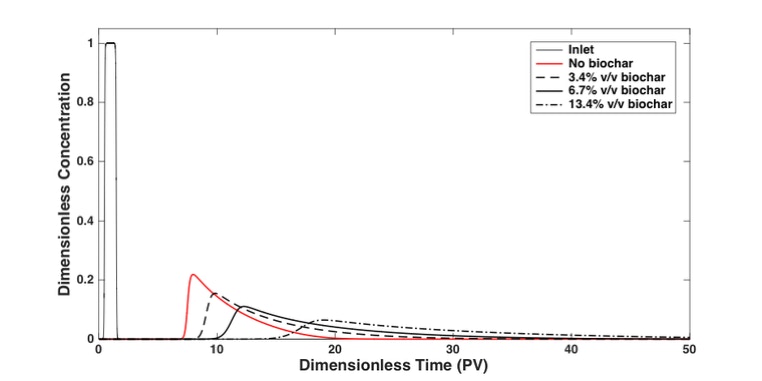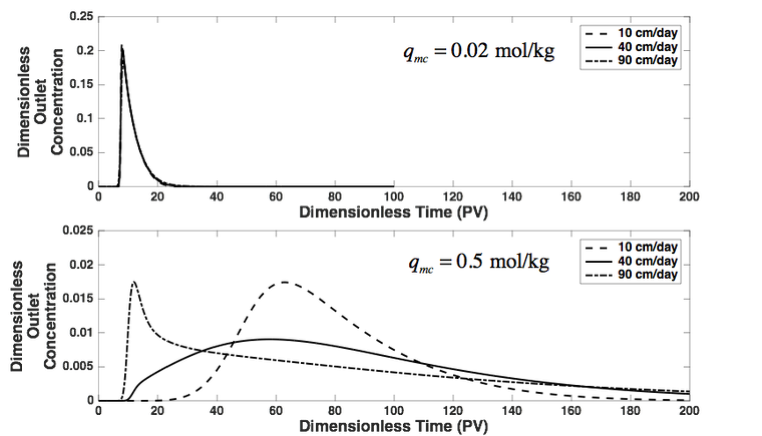Dynamic Modeling of the Nitrogen Cycle in Biochar-Amended Soils:
A New Approach for Rapid Screening of Designer Biochars
Maintaining a sustainable food supply in the future without excessive environmental degradation will require novel engineering approaches for remediating the human disruption of the nitrogen cycle. Over the past several decades, food production has been able to keep pace with human population growth thanks to the development of new high-yielding crop varieties optimally grown with the help of fertilizers.
Unfortunately, more than half of the N fertilizer applied to a field is not available for plant growth due to losses caused by surface runoff, leaching into surface and ground water, or volatilization. As a result, the increased use of N as fertilizer has been linked to a variety of water pollution problems ranging from the expansion of the hypoxic zone in the Gulf of Mexico caused by eutrophication to the contamination of wells and groundwater with nitrate N. More importantly, denitrification reactions occurring in saturated soils convert nitrate to nitrous oxide, a major greenhouse gas and significant contributor to the depletion of atmospheric ozone
Several studies have reported that the addition of biochars to weathered tropical or temperate region soils decreased leaching losses of nutrients. In other cases, however, biochar amendments did not have the expected beneficial effects. Such contradictory results generated a lot of interest in the production of designer biochars, which are engineered to provide specific services. Although the idea of designer biochars seems reasonable, their production becomes a daunting problem. There are dozens of feedstocks from which biochars can be produced in multiple types of reactors under varying temperature and oxygen conditions, quickly leading to thousands of potential biochars with widely varying properties. Then, each of these biochars must be added to a wide range of soil types. For each biochar-soil type pair to be tested in a field trial, farmland must be allocated in statistical replicates for multiple cropping seasons (ideally for 3-5 years). Clearly, this is a very time-consuming process that may take decades to implement.
In an effort to speed up this process, we have begun to develop a computational framework that will allow us to rapidly assess the environmental performance of biochars and guide their application as soil amendments. The amendment of soils with biochar introduces a new stationary phase that necessitates an extension to the classical dual porosity models that considered pore diffusion but only one adsorbent (stationary) phase. Biochars are highly porous materials with interconnected networks of pores that span multiple length scales: from sub-nanometer micropores to macropores with sizes of the order of 10 μm or larger. Moreover, the size and adsorption capacity of biochar particles may be significantly different than the corresponding properties of soil particles.
To properly account for all these factors, we developed a dynamic convection-dispersion-adsorption model that considers nutrient transport through beds with two porous adsorbent phases: soil and biochar. Intraparticle diffusion of the nutrient in both stationary phases was also considered and Langmuir isotherms were employed to describe the local equilibria between the solute diffusing in liquid-filled pores and the solute adsorbing on the pore surfaces of the biochar and soil particles. The resulting system of PDEs was solved numerically using the method of lines.
Simulation results demonstrate that addition of biochar can effectively slow nutrient transport through the soil if the biochar/soil ratio and crucial biochar properties (like its adsorption capacity and affinity to the sorbate) are carefully matched to the soil properties (water velocity, soil type) and the amount of rainfall or irrigation. Simulations can also track the spatial and temporal evolution of nutrient concentration profiles and identify the factors that modulate nutrient partitioning between the soil and biochar phases.

Figure 1: Input and output pulses for a typical simulation run with a bed packed with soil (red line) or soil and biochar particles. Fertilizer is applied in the form of a single rectangular pulse that is followed by pure water flow for the duration of the simulation run. The dimensionless time gives the total volume of liquid that has flown through the bed over a time period and is measured in units of the total volume of interstitial voids in the bed.
By allowing us to isolate and analyze the interactions of key components of our system, the mathematical model provides a systematic way for adjusting the amount and properties of a biochar in order to maximize its agricultural benefits. The amount of biochar applied to a field, for example, could be matched to the hydrodynamic characteristics (permeability, pore water velocity, soil type) of a specific field or to the amount of expected rainfall in order to achieve the desired nutrient retention effects. Or, we could select a feedstock and production method that would yield a biochar with optimal adsorption capacity and sorbate affinity. At the same time, the model can tell us when the application of a biochar will not work. For example, simulations have identified several cases where the addition of biochar would not provide significant benefits either because the biochar has low adsorption capacity (e.g. cation exchange capacity in the case of ammonium fertilizer), or weak affinity to the nutrient/sorbate or because it has been applied to a highly permeable soil characterized by high pore water velocities.

Figure 2: When the total adsorption capacity q
mc of biochar is very low (top panel), our simulations predict that addition of 6.7% v/v of biochar does not slow down the transport of nutrient. Biochars with high values of the total adsorption capacity (bottom panel, q
mc = 0.5 mol/kg) are required to achieve significant environmental benefits.
� Kyriacos Zygourakis 2020
